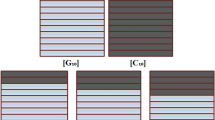Abstract
Self-repair materials or self-healing composites had made a prominent role in present scenario, which can heal the damages occurred by accidents inside and outside body by itself without any external efforts. In the present study hybrid matrix, trimethoxy propyl silane (TMPS) treated carbon fibers and vascular tube reinforced hybrid matrix self-healing composites are fabricated by VARTM technique. Tensile, flexural and low velocity impact properties of the composites were tested. Self-healing effect is compared through low velocity impact test by comparing the strength before damage and after healing. Three types of healing agents i.e., vinyl ester, epoxy and hybrid resin were used in vascular tubes. Hybrid resin filled vascular tubes inserted composites are proved to be the best with 98.03 % healing efficiency. Characterization with C-Scan is done to know damage effect inside the composite. The tensile and flexural strengths of composites with vascular tubes are 249.94 and 184.91 MPa respectively. The overall results concluded that the manufactured self-healing composites have both mechanical strength and self-healing performance. Thus this approach provides a novel path to researchers for the development of self-healing composites in an economical way.
Similar content being viewed by others
References
K. Krishan Chawla in “Composite Materials”, Springer Link, Birmingham, USA, 2012.
H. Abramovich in “Stability and Vibrations of Thin Walled Composite Structures”, Elsevier Science & Technology; Woodhead Publishing, United Kingdom, 2017.
S.-J. Park and M.-K. Seo, Interface Sci. Technol., 21, 1 (2018).
Ravindra K. Dhir OBE, Jorge de Brito, Raman Mangabhai, Chao Qun Lye in “3 Production and Properties of Copper Slag’, Sustainable Construction Materials: Copper Slag”, 27–86, Sustainable Construction Materials, Woodhead Publishing Series in Civil and Structural Engineering, United Kingdom, 2017.
D. Ratna in “Handbook of Thermoset Resins”, ISmithers Rapra Publishing, 2009.
Rocio Yaneli Aguirre-Loredo, Gonzalo Velazquez, Miguel C. Gutierrez, Javier Castro-Rosas, Esmeralda Rangel-Vargas, Carlos Alberto Gómez-Aldapa, Food Packaging and Shelf Life, 17, 162 (2018).
M. Biron in “Thermosets and Composites”, 2nd ed., Elsevier, Waltham, USA, 2013.
J. M. Margolis in “Advanced Thermoset Composites: Industrial and Commercial Applications”, Van Nostrand Reinhold, 1986.
S. Beland in “High-performance Thermoplastic Resins and Their Composites”, William Andrew, Canada, 2012.
M. N. Prabhakar, A. U. R. Shah, and J.-I. Song, Carbohydr. Polym., 168, 201 (2017).
J. Flynn, A. Amiri, and C. Ulven, Mater. Des., 102, 21 (2016).
M. Venkata Ramana and S. Ramprasad, Materials Today: Proceedings, 4, 8654 (2017).
S. Kumar, B. Gangil, L. Prasad, and V. Kumar Patel, Materials Today: Proceedings, 4, 9576 (2017).
D. K. Jesthi, P. Mandal, A. K. Rout, and R. K. Nayak, Procedia Manufacturing, 20, 530 (2018).
J. Liang, M. C. Saha, and M. C. Altan, Procedia Engineering, 56, 814 (2013).
T. Alomayri, F. U. A. Shaikh, and I. M. Low, Mater. Des., 57, 360 (2014).
R. Haik, E. Adiel Sasi, and A. Peled, Cement and Concrete Composites, 80, 1 (2017).
D. Cai, G. Zhou, X. Wang, C. Li, and J. Deng, Polymer Testing, 58, 142 (2017).
M. M. Houck and J. A. Siegel in “Fundamentals of Forensic Science”, 3rd ed., Academic Press, 2015.
S.-B. Park, D.-W. Lee, and J.-I. Song, Int. J. Precision Eng. Manufact., 19, 441 (2018).
M. Parvinzadeh, Global J. Phys. Chem., 3, 2 (2012).
B. Wang, Q. Fu, T. Yin, H. Li, L. Qi, and Y. Fu, Carbon, 139, 45 (2018).
J. Donnini, V. Corinaldesi, and A. Nanni, Compos. Part B: Eng., 88, 220 (2016).
Y. Ma, T. Yokozeki, M. Ueda, T. Sugahara, Y. Yang, and H. Hamada, Compos. Sci. Technol., 151, 268 (2017).
R. S. Trask, H. R. Williams, and I. P. Bond, Bioinspiration & Biomimetics, 12, 1 (2007).
S. M. Bleay, C. B. Loader, V. J. Hawyes, L. Humberstone, and P. T. Curtis, Compos. Pt. A-Appl. Sci. Manuf., 32, 1767 (2001).
R. P. Woo and K. M. O’Conner, J. Appl. Phys., 52, 5953 (1982).
M. R. Kessler, Part G: J. Aerospace Eng., 221, 479 (2007).
Y. Wang, D. T. Pham, and C. Ji, Cogent Engineering, 2, 1075686 (2015).
Author information
Authors and Affiliations
Corresponding author
Rights and permissions
About this article
Cite this article
Latif, M., Kumar, C.N., Prabhakar, M. et al. Development of Hybrid Composites with Improved Mechanical and Self-healing Properties. Fibers Polym 20, 413–420 (2019). https://doi.org/10.1007/s12221-019-8734-1
Received:
Revised:
Accepted:
Published:
Issue Date:
DOI: https://doi.org/10.1007/s12221-019-8734-1




